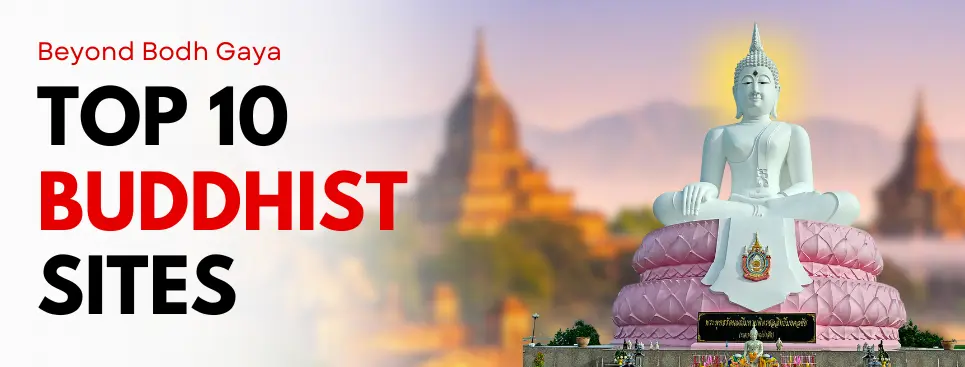Top 10 Buddhist destinations in 2024
Are you looking for an unforgettable discovery of inner peace and cultural immersion? In this blog we explore the gateway to the top 10 Buddhist destinations of dreams in 2024, simplifying your visa and immigration process for a seamless trip.
1. Bodh Gaya, India:
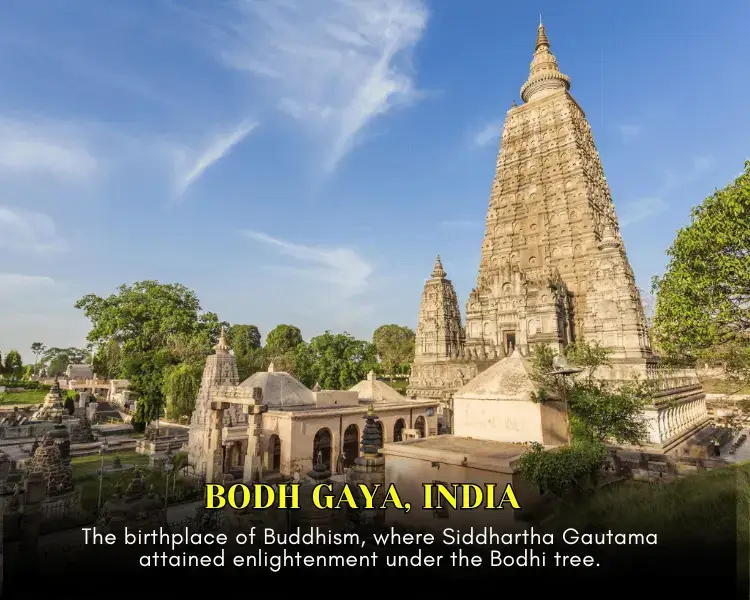
The holy site where Siddhartha Gautama attained enlightenment under the Bodhi tree, Bodh Gaya is the most sacred place in Buddhism. The Mahabodhi Temple, a UNESCO World Heritage Site, is a stunning example of ancient Indian architecture and houses the sacred Bodhi tree.
Time: The best time to visit Bodh Gaya is during the cooler months, from October to March. Avoid the monsoon season (July-September) due to heavy rains.
Money: Budget around ₹3,000-₹5,000 per day for accommodation, food, and transportation. You can find budget-friendly guesthouses and monasteries for cheaper stays.
How to reach: Bodh Gaya has its own airport (Gaya Airport) with connections to major Indian cities. You can also take trains from Delhi or Kolkata.
2. Lumbini, Nepal:
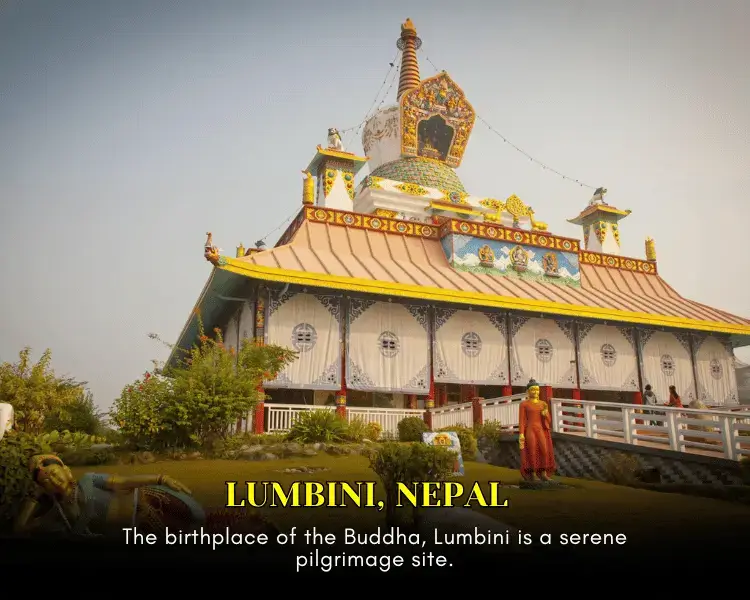
The birthplace of Siddhartha Gautama, Lumbini is a serene and spiritual place. The Lumbini Garden, another UNESCO World Heritage Site, is home to the Maya Devi Temple, marking the spot where Buddha was born.
Time: October to March offers pleasant weather, while April-May and September-October are warmer but still manageable. Avoid the monsoon season (June-August).
Money: Budget around $30-50 per day for basic expenses. Lumbini has a range of accommodation options, from guesthouses to luxury hotels.
How to reach: Bhairahawa Airport, near the border with India, is the closest airport. You can also take buses or trains from Kathmandu.
3. Sarnath, India:
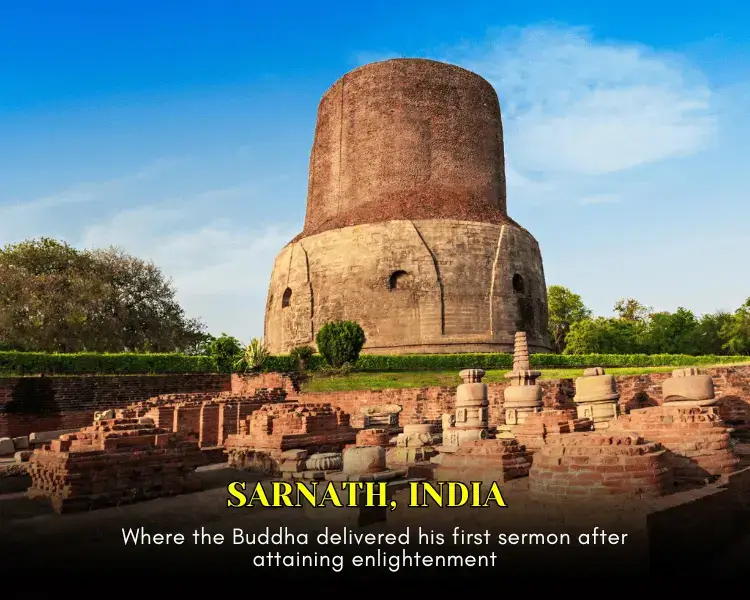
Where Buddha delivered his first sermon after enlightenment, Sarnath is a significant pilgrimage site for Buddhists. The Dhamek Stupa, marking the spot of the first sermon, is a beautiful example of Mauryan architecture.
Time: Similar to Bodh Gaya, October to March is ideal. Avoid the monsoon season.
Money: Budget around ₹2,000-₹3,000 per day. Sarnath offers budget-friendly options like Dharamshalas (pilgrim rest houses) and guesthouses.
How to reach: Varanasi Airport is the closest airport, with connections to major Indian cities. You can also take trains from Delhi or Kolkata.
APPLY TOURIST VISA TODAY!
4. Bagan, Myanmar:
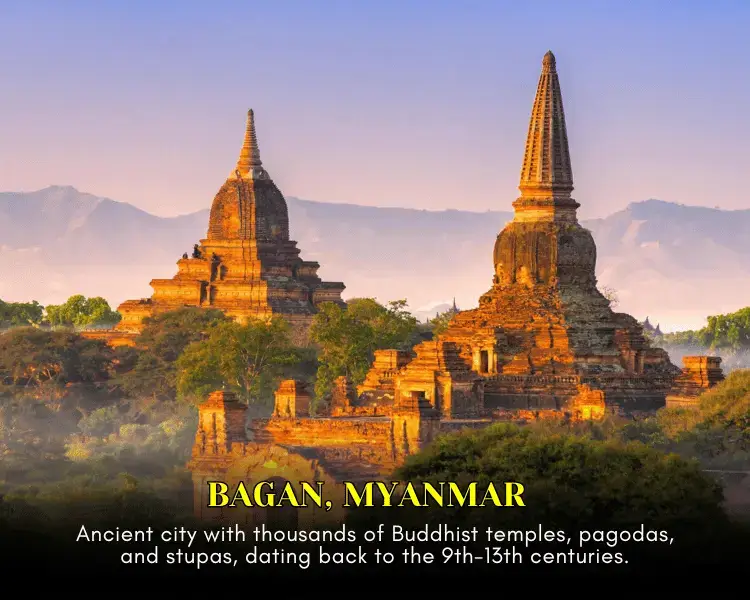
An ancient city dotted with thousands of pagodas and temples, Bagan is a truly magical place. The Ananda Pagoda, with its four massive standing Buddhas, is a must-see.
Time: The dry season, from October to April, is the best time to visit Bagan. The hottest months are May and June.
Money: Budget around $50-100 per day for basic expenses. Bagan has a variety of accommodation options, including guesthouses, homestays, and luxury hotels.
How to reach: Naypyidaw Airport is the closest airport with international connections. You can also take domestic flights from Yangon or Mandalay.
5. Thimphu, Bhutan:
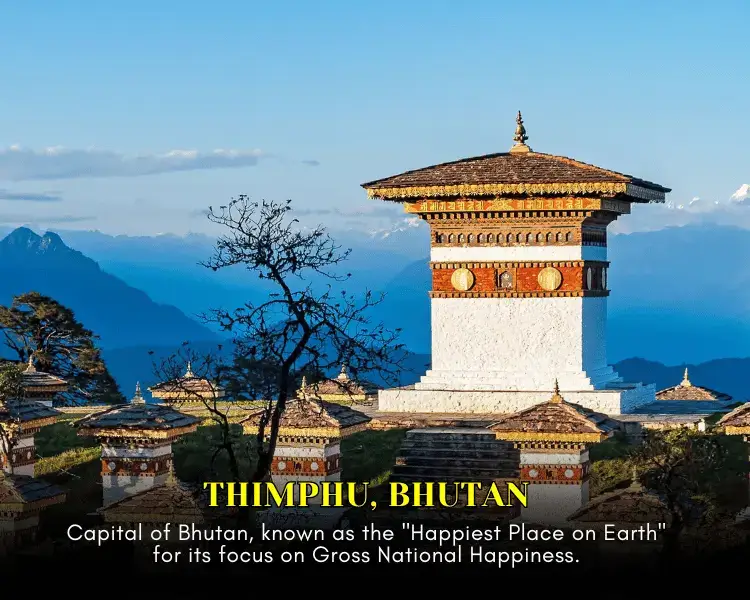
The capital of Bhutan, Thimphu is a charming city with a strong Buddhist culture. The Buddha Dordenma, a giant Buddha statue overlooking the city, is a popular pilgrimage site.
Time: Spring (March-May) and autumn (September-November) offer pleasant weather. Avoid the monsoon season (June-August) and harsh winters (December-February).
Money: Bhutan requires a daily minimum spending of $250 per person, which covers most expenses like accommodation, meals, and sightseeing.
How to reach: Paro Airport is the only international airport in Bhutan. You can also take a scenic road trip from Phuntsholing, on the border with India.
ALSO READ
6. Luang Prabang, Laos:

A UNESCO World Heritage City, Luang Prabang is known for its beautiful temples and monasteries. The Wat Xieng Thong, with its gold-leafed exterior, is particularly stunning.
Time: The dry season, from November to April, offers pleasant weather. Avoid the rainy season (May-October).
Money: Budget around $30-50 per day for basic expenses. Luang Prabang has a range of accommodation options, from guesthouses to boutique hotels.
How to reach: Luang Prabang Airport has connections to major Southeast Asian cities. You can also take buses or boats from other parts of Laos.
7. Borobudur, Indonesia:
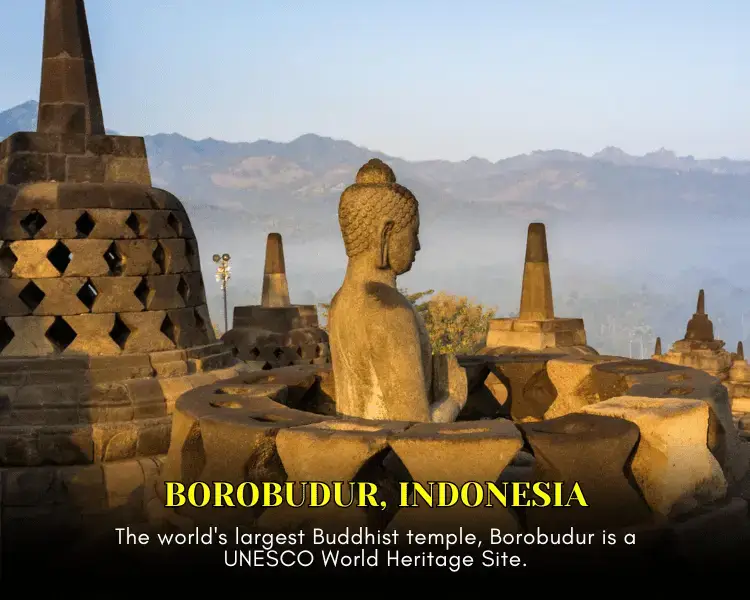
The world's largest Buddhist temple, Borobudur is a UNESCO World Heritage Site and an architectural marvel. The temple is decorated with thousands of reliefs depicting the life of Buddha and Buddhist teachings.
Time: The dry season, from May to September, offers the best weather. Avoid the rainy season (October-April).
Money: Budget around IDR 500,000-1,000,000 (approx. $35-70) per day for basic expenses. Borobudur offers budget-friendly options like homestays and guesthouses.
How to reach: Yogyakarta Airport is the closest airport with international connections. You can also take trains or buses from other parts of Java.
8. Ha Long Bay, Vietnam:

While not strictly a Buddhist destination, Ha Long Bay's stunning scenery and serene atmosphere make it a perfect place for meditation and reflection. Boat trips through the bay offer breathtaking views of the limestone karst formations.
Time: October to April offers the most pleasant weather. Avoid the typhoon season (July-September) and winter months (December-February).
Money: Budget around $50-100 per day for basic expenses. Ha Long Bay offers a variety of accommodation options, including boat cruises, guesthouses, and luxury resorts.
How to reach: Cat Bi International Airport in Haiphong is the closest airport. You can also take trains or buses from Hanoi.
9. Koyasan, Japan:
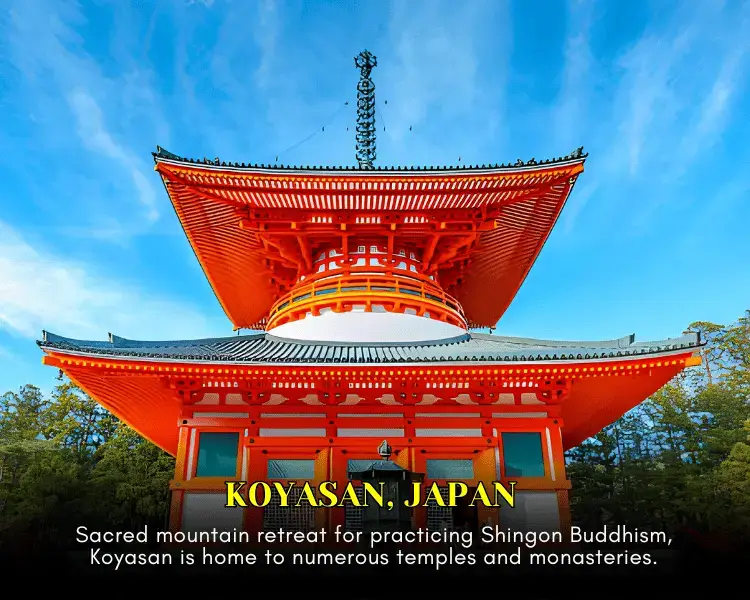
A sacred mountain retreat for Shingon Buddhism, Koyasan is home to numerous temples and monasteries. The Okunoin Cemetery, where thousands of statues and gravestones line the path, is a particularly moving sight.
Time: Spring (April-May) and autumn (September-November) offer comfortable temperatures. Avoid the coldest months (December-February) and the rainy season (June-July).
Money: Budget around ¥10,000-¥20,000 (approx. $80-150) per day for basic expenses. Koyasan has traditional temple lodging (shukubo) which offer unique experiences.
How to reach: Kansai International Airport in Osaka is the closest airport. You can then take a train and cable car to reach Koyasan.
10. Paro Taktsang, Bhutan:

Also known as Tiger's Nest Monastery, Paro Taktsang is a cliffside monastery that appears to cling to the side of a mountain. The hike to the monastery is challenging but the views are worth it.
Time: Spring (March-May) and autumn (September-November) offer the best weather and hiking conditions. Avoid the monsoon season (June-August) and harsh winters (December-February).
Money: You'll need to cover the minimum daily spending of $250 per person, as required by Bhutan tourism regulations. This includes most expenses like accommodation, meals, and sightseeing.
How to reach: Paro Airport is the only international airport in Bhutan. You can also take a scenic road trip from Phuntsholing, on the border with India.
FAQ's
Q.) What are the most important Buddhist pilgrimage sites beyond the usual suspects like Bodh Gaya and Lumbini?
Banteay Srei, Cambodia: Witness intricate sandstone carvings depicting Hindu and Buddhist mythology in this "Citadel of the Women.
Dazu Rock Carvings, China: Immerse yourself in a 1,500-year-old tapestry of Buddhist art and stories carved into cliffs.
Wat Rong Khun, Thailand: Marvel at the dazzling "White Temple," adorned with mosaics and contemporary Buddhist interpretations.
Borobudur, Indonesia: Ascend the world's largest Buddhist temple, a masterpiece adorned with intricate reliefs and stunning views.
Ha Long Bay, Vietnam: Cruise through this serene seascape dotted with limestone karsts, finding peace amidst the majesty of nature.
Q.) How can I have a budget-friendly and responsible pilgrimage experience, including volunteering opportunities and sustainable travel options?
Volunteering: Offer your time and skills at monasteries or NGOs, learning from locals and contributing to the community.
Homestays & Guesthouses: Opt for budget-friendly accommodations that support local families and minimize your environmental footprint.
Public Transport: Embrace local trains, buses, or boats, experiencing the rhythm of daily life and saving costs.
Free Activities: Explore local markets, temples with free entry, or serene parks, immersing yourself in the cultural tapestry.
Responsible Souvenirs: Choose ethically sourced handicrafts or support local food stalls, ensuring your purchases benefit the community.
Q) What are the essential packing tips for Buddhist destinations, considering climate, cultural sensitivity, and specific activities?
Climate-conscious: Pack breathable fabrics for warm destinations and layers for cooler climates.
Cultural Sensitivity: Research local dress codes and opt for modest clothing that covers knees and shoulders in conservative areas.
Activity-Specific: Bring comfortable walking shoes for temple explorations and quick-drying clothes for outdoor activities.
Essentials: Don't forget a reusable water bottle, sunscreen, and a hat to protect yourself from the elements.
Adaptability: Pack versatile clothing that can be mixed and matched, maximizing space in your luggage.
Q- What are the upcoming Buddhist festivals and events in 2024
Mönlam, Tibet (February-March): Celebrate the Tibetan New Year with vibrant prayer flags, traditional dances, and a joyous atmosphere.
Wesak, Sri Lanka (May): Witness colourful processions, lantern displays, and chanting that commemorate the birth, enlightenment, and death of the Buddha.
Bun Bang Fai, Laos (July): Experience this unique rocket festival, where rockets carrying offerings soar into the sky for good fortune.
Kathmandu Dashain, Nepal (October): Immerse yourself in the largest festival of Nepal, celebrating the victory of good over evil with vibrant parades and cultural performances.
Loy Krathong, Thailand (November): Release beautifully crafted lanterns on rivers and waterways, making a wish for good luck and prosperity.
Q.) It safe to travel solo as a woman to specific Buddhist countries?
Research & Preparation: Study local customs, safety tips, and essential phrases in the local language.
Trust Your Instincts: If something feels wrong, don't hesitate to move away or seek help from trusted individuals.
Stay Connected: Share your itinerary and travel updates with loved ones back home.
Accommodation & Transportation: Choose well-lit, reputable hotels and stick to public transportation during daylight hours.
Emergency Resources: Download offline maps, store important contact information, and familiarize yourself with local emergency numbers.
Let Triple I Business Service pave the way for your immersive pilgrimage experience. Let us handle the formalities, while you focus on enriching your soul and finding inner peace.
APPLY TOURIST VISA TODAY!
Contact us today and go on a journey of enlightenment with visa and immigration solutions tailored to your needs.
For more information related to a Buddhist Tourist visa or any other visa Call or WhatsApp: +91 859 574 4633 or Email: [email protected]
Comments
